

Compact Muon Solenoid
LHC, CERN
| CMS-BPH-15-005 ; CERN-EP-2017-267 | ||
| Measurement of quarkonium production cross sections in pp collisions at $\sqrt{s} = $ 13 TeV | ||
| CMS Collaboration | ||
| 30 October 2017 | ||
| Phys. Lett. B 780 (2018) 251 | ||
| Abstract: Differential production cross sections of $\mathrm{J}/\psi$ and $\psi$(2S) charmonium and $\Upsilon$(nS) (n = 1, 2, 3) bottomonium states are measured in proton-proton collisions at $\sqrt{s} = $ 13 TeV, with data collected by the CMS detector at the LHC, corresponding to an integrated luminosity of 2.3 fb$^{-1}$ for the $\mathrm{J}/\psi$ and 2.7 fb$^{-1}$ for the other mesons. The five quarkonium states are reconstructed in the dimuon decay channel, for dimuon rapidity $| y | < $ 1.2. The double-differential cross sections for each state are measured as a function of $y$ and transverse momentum, and compared to theoretical expectations. In addition, ratios are presented of cross sections for prompt $\psi$(2S) to $\mathrm{J}/\psi$, $\Upsilon$(2S) to $\Upsilon$(1S), and $\Upsilon$(3S) to $\Upsilon$(1S) production. | ||
| Links: e-print arXiv:1710.11002 [hep-ex] (PDF) ; CDS record ; inSPIRE record ; HepData record ; CADI line (restricted) ; | ||
| Figures | |

png pdf |
Figure 1:
The product of the measured double-differential cross sections and the dimuon branching fractions for prompt $ {\mathrm{J}/\psi} $ and $ \psi $(2S) (left) and the $\Upsilon $(nS) (right) mesons as a function of $ {p_{\mathrm {T}}} $, in four and two rapidity regions, respectively, assuming unpolarized dimuon decays. For presentation purposes, the individual points in the measurements are scaled by the factors given in the legends. The inner vertical bars on the data points represent the statistical uncertainty, while the outer bars show the statistical and systematic uncertainties, not including the 2.3% uncertainty in the integrated luminosity, added in quadrature. For most of the data points, the uncertainties are comparable to the size of the symbols. |
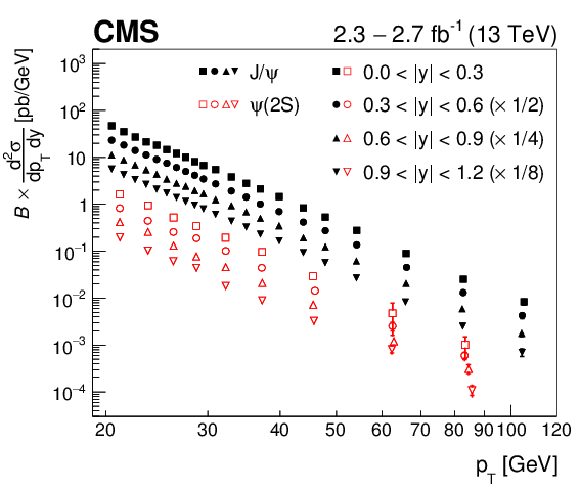
png pdf |
Figure 1-a:
The product of the measured double-differential cross sections and the dimuon branching fractions for prompt $ {\mathrm{J}/\psi} $ and $ \psi $(2S) mesons as a function of $ {p_{\mathrm {T}}} $, in four rapidity regions, assuming unpolarized dimuon decays. For presentation purposes, the individual points in the measurements are scaled by the factors given in the legends. The inner vertical bars on the data points represent the statistical uncertainty, while the outer bars show the statistical and systematic uncertainties, not including the 2.3% uncertainty in the integrated luminosity, added in quadrature. For most of the data points, the uncertainties are comparable to the size of the symbols. |
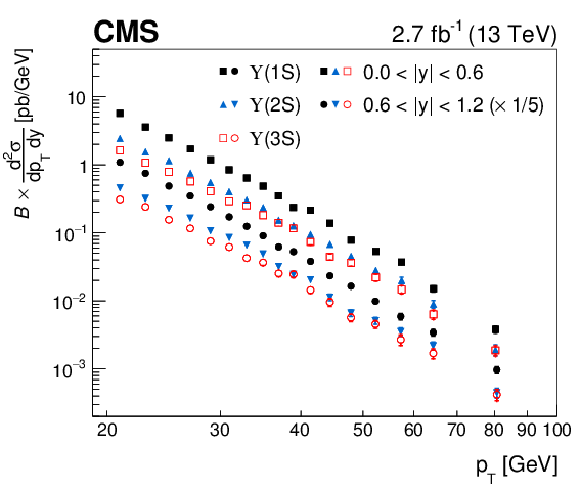
png pdf |
Figure 1-b:
The product of the measured double-differential cross sections and the dimuon branching fractions for prompt $\Upsilon $(nS) mesons as a function of $ {p_{\mathrm {T}}} $, in two rapidity regions, assuming unpolarized dimuon decays. For presentation purposes, the individual points in the measurements are scaled by the factors given in the legends. The inner vertical bars on the data points represent the statistical uncertainty, while the outer bars show the statistical and systematic uncertainties, not including the 2.3% uncertainty in the integrated luminosity, added in quadrature. For most of the data points, the uncertainties are comparable to the size of the symbols. |
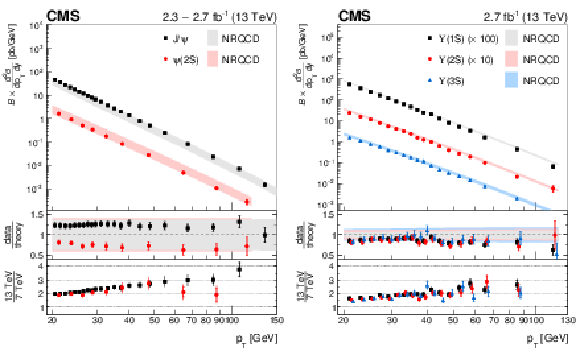
png pdf |
Figure 2:
The measured double-differential cross sections times branching fractions of the prompt $ {\mathrm{J}/\psi} $ and $ \psi $(2S) (left) and the $\Upsilon $(nS) (right) mesons (markers), assuming unpolarized dimuon decays, as a function of $ {p_{\mathrm {T}}} $, for $ {| y |} < $ 1.2, compared to NLO NRQCD predictions| [42,43] (shaded bands). The inner vertical bars on the data points represent the statistical uncertainty, while the outer bars show the statistical and systematic uncertainties, including the integrated luminosity uncertainty of 2.3%, added in quadrature. The middle panels show the ratios of measurement to theory, where the vertical bars depict the total uncertainties in the measurement. The widths of the bands represent the theoretical uncertainty, added in quadrature with the uncertainties in the dimuon branching fractions| [35]. The lower panels show the ratios of cross sections measured at $\sqrt {s} = $ 13 TeV to those measured at 7 TeV | [25,26]. All uncertainties in the 7 and 13 TeV results are treated as uncorrelated. |
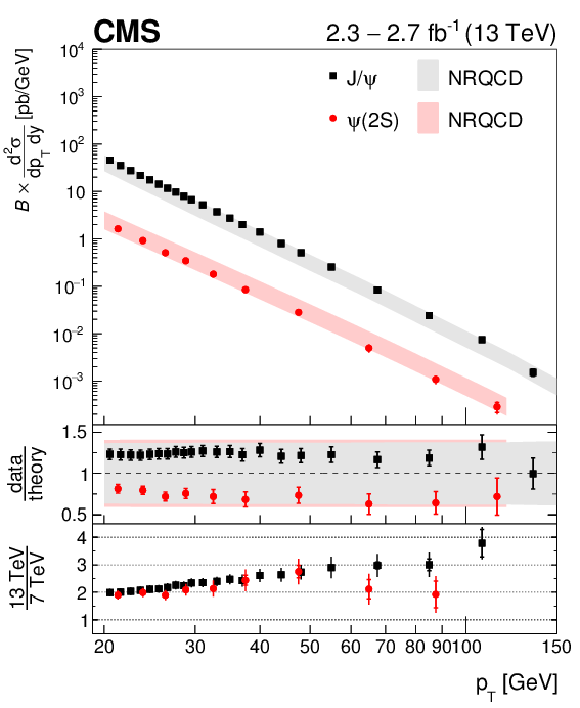
png pdf |
Figure 2-a:
The measured double-differential cross sections times branching fractions of the prompt $ {\mathrm{J}/\psi} $ and $ \psi $(2S) mesons (markers), assuming unpolarized dimuon decays, as a function of $ {p_{\mathrm {T}}} $, for $ {| y |} < $ 1.2, compared to NLO NRQCD predictions| [42,43] (shaded bands). The inner vertical bars on the data points represent the statistical uncertainty, while the outer bars show the statistical and systematic uncertainties, including the integrated luminosity uncertainty of 2.3%, added in quadrature. The middle panel shows the ratios of measurement to theory, where the vertical bars depict the total uncertainties in the measurement. The widths of the bands represent the theoretical uncertainty, added in quadrature with the uncertainties in the dimuon branching fractions| [35]. The lower panel shows the ratios of cross sections measured at $\sqrt {s} = $ 13 TeV to those measured at 7 TeV | [25,26]. All uncertainties in the 7 and 13 TeV results are treated as uncorrelated. |
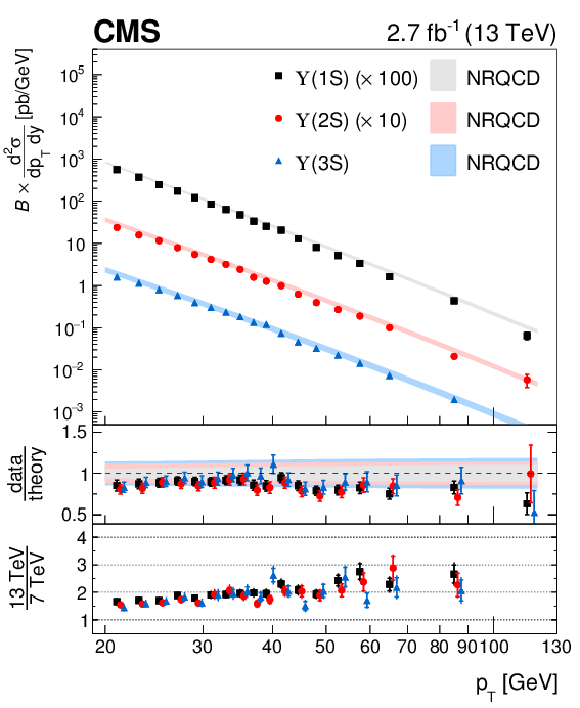
png pdf |
Figure 2-b:
The measured double-differential cross sections times branching fractions of the prompt $\Upsilon $(nS) mesons (markers), assuming unpolarized dimuon decays, as a function of $ {p_{\mathrm {T}}} $, for $ {| y |} < $ 1.2, compared to NLO NRQCD predictions| [42,43] (shaded bands). The inner vertical bars on the data points represent the statistical uncertainty, while the outer bars show the statistical and systematic uncertainties, including the integrated luminosity uncertainty of 2.3%, added in quadrature. The middle panel shows the ratios of measurement to theory, where the vertical bars depict the total uncertainties in the measurement. The widths of the bands represent the theoretical uncertainty, added in quadrature with the uncertainties in the dimuon branching fractions| [35]. The lower panel shows the ratios of cross sections measured at $\sqrt {s} = $ 13 TeV to those measured at 7 TeV | [25,26]. All uncertainties in the 7 and 13 TeV results are treated as uncorrelated. |
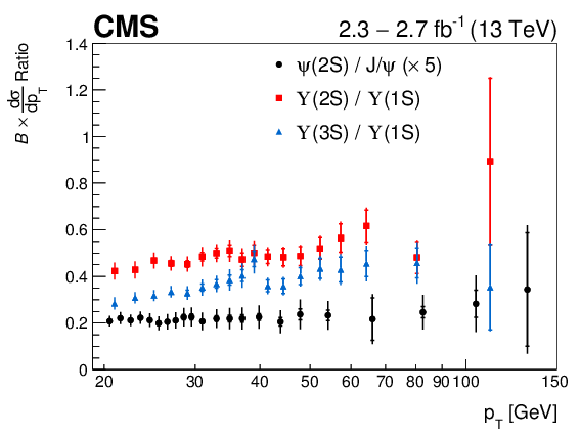
png pdf |
Figure 3:
Ratios of the $ {p_{\mathrm {T}}} $ differential cross sections times dimuon branching fractions of the prompt $ \psi $(2S) to $ {\mathrm{J}/\psi} $, $\Upsilon $(2S) to $\Upsilon $(1S), and $\Upsilon $(3S) to $\Upsilon $(1S) mesons for $ {| y |} < $ 1.2. The inner vertical bars represent the statistical uncertainty, while the outer bars show the statistical and systematic uncertainties added in quadrature. The ratio of the $ \psi $(2S) to $ {\mathrm{J}/\psi} $ meson cross sections is multiplied by a factor 5 for better visibility. |
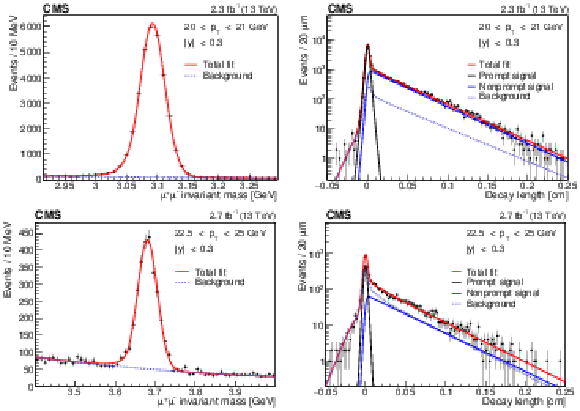
png pdf |
Figure A1:
Examples of fits of the dimuon invariant mass (left) and decay length (right) distributions for $ {\mathrm{J}/\psi} $ (upper row) and $ \psi $(2S) (lower row) candidate events in the $ {p_{\mathrm {T}}} $ and $ {| y |}$ ranges given in the plots. The results from the total fit and from the various components included in the fit are shown. |
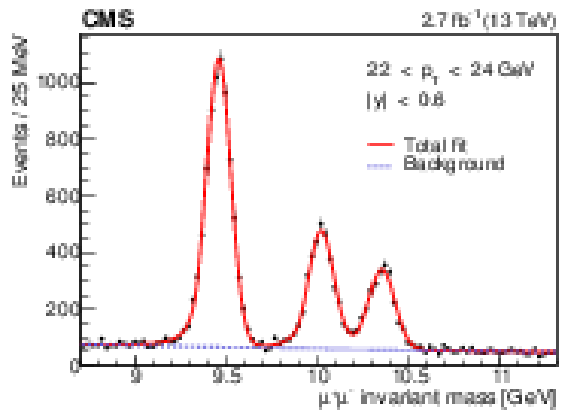
png pdf |
Figure A2:
Examples of a fit of the dimuon invariant mass distribution for the $\Upsilon $(nS) candidate events in the $ {p_{\mathrm {T}}} $ and $ {| y |}$ ranges given in the plot. The results from the total fit and for the background component are shown. |
| Tables | |
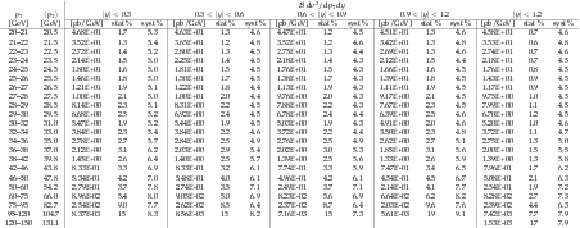
png pdf |
Table A1:
Double-differential cross section times the dimuon branching fraction of the $ {\mathrm{J}/\psi} $ meson for different ranges of $ {p_{\mathrm {T}}} $, in bins of $ {| y |}$ and for the full $ {| y |}$ range, for the unpolarized decay hypothesis, with their statistical and systematic uncertainties in percent. The average $ {p_{\mathrm {T}}} $ value in each bin is also given. The global uncertainty in the integrated luminosity of 2.3% is not included in the systematic uncertainties. |

png pdf |
Table A2:
Double-differential cross section times the dimuon branching fraction of the $ \psi $(2S) meson for different ranges of $ {p_{\mathrm {T}}} $, in bins of $ {| y |}$ and for the full $ {| y |}$ range, for the unpolarized decay hypothesis, with their statistical and systematic uncertainties in percent. The average $ {p_{\mathrm {T}}} $ value in each bin is also given. The global uncertainty in the integrated luminosity of 2.3% is not included in the systematic uncertainties. |
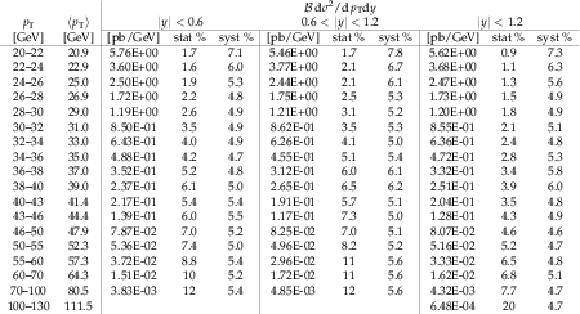
png pdf |
Table A3:
Double-differential cross section times the dimuon branching fraction of the $\Upsilon $(1S) meson for different ranges of $ {p_{\mathrm {T}}} $, in bins of $ {| y |}$ and for the full $ {| y |}$ range, for the unpolarized decay hypothesis, with their statistical and systematic uncertainties in percent. The average $ {p_{\mathrm {T}}} $ value in each bin is also given. The global uncertainty in the integrated luminosity of 2.3% is not included in the systematic uncertainties. |
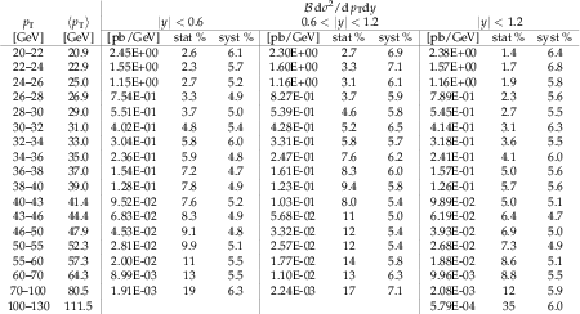
png pdf |
Table A4:
Double-differential cross section times the dimuon branching fraction of the $\Upsilon $(2S) meson for different ranges of $ {p_{\mathrm {T}}} $, in bins of $ {| y |}$ and for the full $ {| y |}$ range, for the unpolarized decay hypothesis, with their statistical and systematic uncertainties in percent. The average $ {p_{\mathrm {T}}} $ value in each bin is also given. The global uncertainty in the integrated luminosity of 2.3% is not included in the systematic uncertainties. |

png pdf |
Table A5:
Double-differential cross section times the dimuon branching fraction of the $\Upsilon $(3S) meson for different ranges of $ {p_{\mathrm {T}}} $, in bins of $ {| y |}$ and for the full $ {| y |}$ range, for the unpolarized decay hypothesis, with their statistical and systematic uncertainties in percent. The average $ {p_{\mathrm {T}}} $ value in each bin is also given. The global uncertainty in the integrated luminosity of 2.3% is not included in the systematic uncertainties. |

png pdf |
Table A6:
Multiplicative scaling factors to obtain the $ {\mathrm{J}/\psi} $ differential cross sections for different polarization scenarios ($ {\lambda _{\theta}^{\mathrm {HX}}}= +1$, $k$, $-1$) from the unpolarized cross section measurements given in Table A1. The value of $k$ is taken equal to $+0.10$, and corresponds to an average over $ {p_{\mathrm {T}}} $ of the CMS measurement [30]. |

png pdf |
Table A7:
Multiplicative scaling factors to obtain the $ \psi $(2S) differential cross sections for different polarization scenarios ($ {\lambda _{\theta}^{\mathrm {HX}}}= +1$, $k$, $-1$) from the unpolarized cross section measurements given in Table A1. The value of $k$ is taken equal to $+0.03$, and corresponds to an average over $ {p_{\mathrm {T}}} $ of the CMS measurement [30]. |

png pdf |
Table A8:
Multiplicative scaling factors to obtain the $\Upsilon $(1S) differential cross sections for different polarization scenarios ($ {\lambda _{\theta}^{\mathrm {HX}}}= +1$, $k$, $-1$) from the unpolarized cross section measurements given in Table A3. The parameter $k$ corresponds to a linear interpolation of the CMS measured value of $ {\lambda _{\theta}^{\mathrm {HX}}}$ [31] as a function of $ {p_{\mathrm {T}}} $ for $ {p_{\mathrm {T}}} < $ 50 GeV. For $ {p_{\mathrm {T}}} > $ 50 GeV, where no measurements of $ {\lambda _{\theta}^{\mathrm {HX}}} $ exist, $k$ is taken as the average of all the measured values of $ {\lambda _{\theta}^{\mathrm {HX}}} $ for $ {p_{\mathrm {T}}} < $ 50 GeV. |
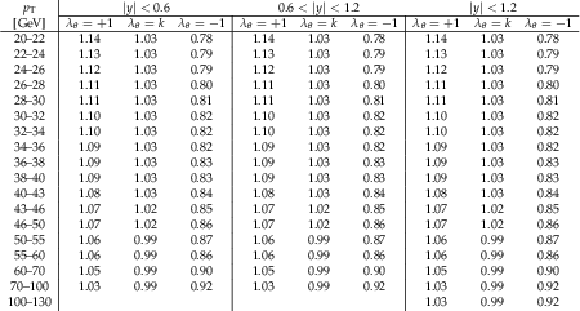
png pdf |
Table A9:
Multiplicative scaling factors to obtain the $\Upsilon $(2S) differential cross sections for different polarization scenarios ($ {\lambda _{\theta}^{\mathrm {HX}}}= +1, k, -1$) from the unpolarized cross section measurements given in Table A4. The parameter $k$ corresponds to a linear interpolation of the CMS measured value of $ {\lambda _{\theta}^{\mathrm {HX}}}$| [31] as a function of $ {p_{\mathrm {T}}} $ for $ {p_{\mathrm {T}}} < $ 50 GeV. For $ {p_{\mathrm {T}}} > $ 50 GeV, where no measurements of $ {\lambda _{\theta}^{\mathrm {HX}}} $ exist, $k$ is taken as the average of all the measured values of $ {\lambda _{\theta}^{\mathrm {HX}}} $ for $ {p_{\mathrm {T}}} < $ 50 GeV. |
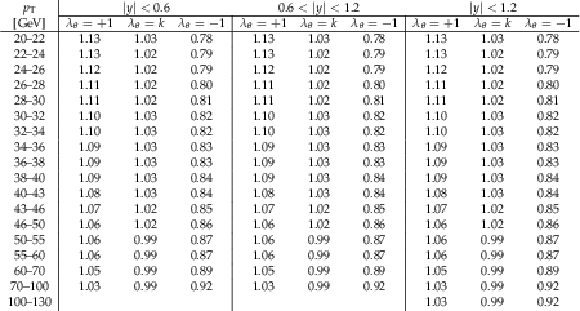
png pdf |
Table A10:
Multiplicative scaling factors to obtain the $\Upsilon $(3S) differential cross sections for different polarization scenarios ($ {\lambda _{\theta}^{\mathrm {HX}}}= +1$, $k$, $-1$) from the unpolarized cross section measurements given in Table A5. The parameter $k$ corresponds to a linear interpolation of the CMS measured value of $ {\lambda _{\theta}^{\mathrm {HX}}}$ [31] as a function of $ {p_{\mathrm {T}}} $ for $ {p_{\mathrm {T}}} < $ 50 GeV. For $ {p_{\mathrm {T}}} > $ 50 GeV, where no measurements of $ {\lambda _{\theta}^{\mathrm {HX}}} $ exist, $k$ is taken as the average of all the measured values of $ {\lambda _{\theta}^{\mathrm {HX}}} $ for $ {p_{\mathrm {T}}} < $ 50 GeV, which are all consistent with a single value. |
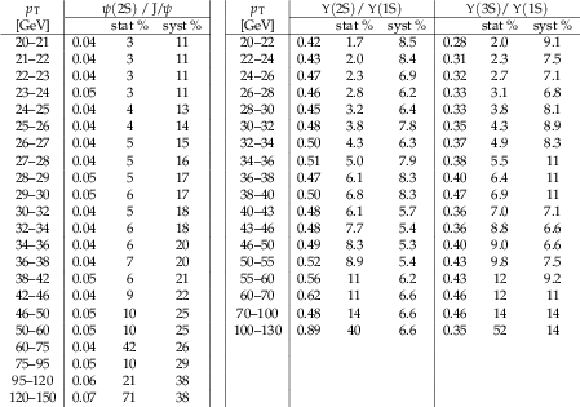
png pdf |
Table A11:
Ratios of the $ {p_{\mathrm {T}}} $ differential cross sections times dimuon branching fractions of the prompt $ \psi $(2S) to $ {\mathrm{J}/\psi} $, $\Upsilon $(2S) to $\Upsilon $(1S), and $\Upsilon $(3S) to $\Upsilon $(1S) mesons for $ {| y |} < $ 1.2, with their statistical and systematic uncertainties in percent. |
| Summary |
| The double-differential production cross sections of the $\mathrm{J}/\psi$, $\psi$(2S), and $\Upsilon$(nS) (n = 1, 2, 3) quarkonium states have been measured, using their dimuon decay mode, in pp collisions at $\sqrt{s} = $ 13 TeV with the CMS detector at the LHC. The production cross sections of all five S-wave states are presented in a single analysis. The measurement has been performed as a function of transverse momentum (${p_{\mathrm{T}}}$) in several bins of rapidity ($y$), covering a ${p_{\mathrm{T}}}$ range 20-120 GeV for the $\mathrm{J}/\psi$ meson and 20-100 GeV for the remaining states. The cross sections integrated over $| y | < $ 1.2 are also presented, and extend the ${p_{\mathrm{T}}}$ reach to 150 and 130 GeV, respectively. Also presented are the ratios of cross sections measured at $\sqrt{s} = $ 13 (this analysis) and 7 TeV (from Refs. [25,26]), as well as the cross sections of the prompt $\psi$(2S), $\Upsilon$(2S), and $\Upsilon$(3S) mesons relative to their ground states. These results will help in testing the underlying hypotheses of nonrelativistic quantum chromodynamics and in providing further input to constrain the theoretical parameters. |
| References | ||||
| 1 | G. T. Bodwin, E. Braaten, and G. P. Lepage | Rigorous QCD analysis of inclusive annihilation and production of heavy quarkonium | PRD 51 (1995) 1125 | |
| 2 | P. Cho and A. K. Leibovich | Color-octet quarkonia production | PRD 53 (1996) 150 | |
| 3 | P. Cho and A. K. Leibovich | Color-octet quarkonia production. II | PRD 53 (1996) 6203 | |
| 4 | B. Gong, L.-P. Wan, J.-X. Wang, and H.-F. Zhang | Complete next-to-leading-order study on the yield and polarization of $ \Upsilon(1S, $ 2S, 3S) at the Tevatron and LHC | PRL 112 (2014) 032001 | 1305.0748 |
| 5 | Z.-B. Kang, Y.-Q. Ma, J.-W. Qiu, and G. Sterman | Heavy quarkonium production at collider energies: partonic cross section and polarization | PRD 91 (2015) 014030 | 1411.2456 |
| 6 | M. Butenschon and B. A. Kniehl | $ \mathrm{J}/\psi $ polarization at Tevatron and LHC: nonrelativistic-QCD factorization at the crossroads | PRL 108 (2012) 172002 | 1201.1872 |
| 7 | K.-T. Chao et al. | $ \mathrm{J}/\psi $ polarization at hadron colliders in nonrelativistic QCD | PRL 108 (2012) 242004 | 1201.2675 |
| 8 | P. Faccioli et al. | Quarkonium production in the LHC era: a polarized perspective | PLB 736 (2014) 98 | 1403.3970 |
| 9 | G. T. Bodwin, H. S. Chung, U.-R. Kim, and J. Lee | Fragmentation contributions to $ \mathrm{J}/\psi $ production at the Tevatron and the LHC | PRL 113 (2014) 022001 | 1403.3612 |
| 10 | LHCb Collaboration | Measurement of the cross-section ratio $ \sigma(\chi_{\mathrm{c2}})/\sigma(\chi_{\mathrm{c1}}) $ for prompt $ \chi_{\mathrm{c}} $ production at $ \sqrt{s} = $ 7 TeV | PLB 714 (2012) 215 | 1202.1080 |
| 11 | LHCb Collaboration | Measurement of the $ \chi_{\mathrm{b}} $(3P) mass and of the relative rate of $\chi_{\mathrm{b1}}$(1P) and $\chi_{\mathrm{b2}}$(1P) production | JHEP 10 (2014) 88 | 1409.1408 |
| 12 | ATLAS Collaboration | Measurement of $ \chi_{\mathrm{c1}} $ and $ \chi_{\mathrm{c2}} $ production with $ \sqrt{s} = $ 7 TeV pp collisions at ATLAS | JHEP 07 (2014) 154 | 1404.7035 |
| 13 | CMS Collaboration | Measurement of the production cross section ratio $ \sigma(\chi_{\mathrm{b2}}\text{(1P)})/\sigma(\chi_{\mathrm{b1}}\text{(1P)}) $ in pp collisions at $ \sqrt{s} = $ 8 TeV | PLB 743 (2015) 383 | CMS-BPH-13-005 1409.5761 |
| 14 | CMS Collaboration | Measurement of the relative prompt production rate of $ \chi_{\mathrm{c2}} $ and $ \chi_{\mathrm{c1}} $ in pp collisions at $ \sqrt{s} = $ 7 TeV | EPJC 72 (2012) 2251 | CMS-BPH-11-010 1210.0875 |
| 15 | LHCb Collaboration | Measurement of the $ \eta_{\mathrm{c}}\text{(1S)} $ production cross-section in proton-proton collisions via the decay $ \eta_{\mathrm{c}}\text{(1S)} \rightarrow {\mathrm{p}}\mathrm{\bar{p}} $ | EPJC 75 (2015) 311 | 1409.3612 |
| 16 | ATLAS Collaboration | Measurement of the differential cross-sections of inclusive, prompt and non-prompt $ \mathrm{J}/\psi\ $ production in proton-proton collisions at $ \sqrt{s} = $ 7 TeV | NPB 850 (2011) 387 | 1104.3038 |
| 17 | ATLAS Collaboration | Measurement of the production cross-section of $ \psi\text{(2S)} \to \mathrm{J}/\psi (\to \mu^{+} \mu^{-}) \pi^{+} \pi^{-} $ in pp collisions at $ \sqrt{s} = $ 7 TeV at ATLAS | JHEP 09 (2014) 079 | 1407.5532 |
| 18 | ATLAS Collaboration | Measurement of Upsilon production in 7 TeV pp collisions at ATLAS | PRD 87 (2013) 052004 | 1211.7255 |
| 19 | LHCb Collaboration | Measurement of $ \mathrm{J}/\psi\ $ production in pp collisions at $ \sqrt{s} = $ 7 TeV | EPJC 71 (2011) 1645 | 1103.0423 |
| 20 | LHCb Collaboration | Measurement of $ \psi\text{(2S)}\ $ meson production in pp collisions at $ \sqrt{s} = $ 7 TeV | EPJC 72 (2012) 2100 | 1204.1258 |
| 21 | LHCb Collaboration | Measurement of Upsilon production in pp collisions at $ \sqrt{s} = $ 7 TeV | EPJC 72 (2012) 2025 | 1202.6579 |
| 22 | ALICE Collaboration | Measurement of prompt $ \mathrm{J}/\psi\ $ and beauty hadron production cross sections at mid-rapidity in pp collisions at $ \sqrt{s} = $ 7 TeV | JHEP 11 (2012) 065 | 1205.5880 |
| 23 | CMS Collaboration | Measurement of the inclusive $ \Upsilon\ $ production cross section in pp collisions at $ \sqrt{s} = $ 7 TeV | PRD 83 (2011) 112004 | CMS-BPH-10-003 1012.5545 |
| 24 | CMS Collaboration | Measurement of the $ \Upsilon$(1S), $\Upsilon$(2S) and $ \Upsilon$(3S) cross sections in pp collisions at $ \sqrt{s} = $ 7 TeV | PLB 727 (2013) 101 | CMS-BPH-11-001 1303.5900 |
| 25 | CMS Collaboration | Measurement of $ \mathrm{J}/\psi $ and $ \psi\text{(2S)} $ prompt double-differential cross sections in $ pp $ collisions at $ \sqrt{s} = $ 7 TeV | PRL 114 (2015) 191802 | CMS-BPH-14-001 1502.04155 |
| 26 | CMS Collaboration | Measurements of the $ \Upsilon$(1S), $\Upsilon$(2S) and $ \Upsilon$(3S) differential cross sections in pp collisions at $ \sqrt{s} = $ 7 TeV | PLB 749 (2015) 14 | CMS-BPH-12-006 1501.07750 |
| 27 | CMS Collaboration | Suppression of non-prompt $ \mathrm{J}/\psi, $ prompt $ \mathrm{J}/\psi, $ and $ \Upsilon$(1S) in PbPb collisions at $ \sqrt{s_\mathrm{NN}}= $ 2.76 TeV | Journal of High Energy Physics 5 (2012) 63 | |
| 28 | CMS Collaboration | Suppression of $ \Upsilon$(1S), $\Upsilon$(2S) and $ \Upsilon$(3S) production in PbPb collisions at $ \sqrt{s_\mathrm{NN}}= $ 2.76 TeV | PLB 770 (2017) 357 | CMS-HIN-15-001 1611.01510 |
| 29 | ALICE Collaboration | $ \mathrm{J}/\psi $ polarization in $ pp $ collisions at $ \sqrt{s} = $ 7 TeV | PRL 108 (2012) 082001 | 1111.1630 |
| 30 | CMS Collaboration | Measurement of the prompt $ \mathrm{J}/\psi $ and $ \psi\text{(2S)}\ $ polarizations in pp collisions at $ \sqrt{s} = $ 7 TeV | PLB 727 (2013) 381 | CMS-BPH-13-003 1307.6070 |
| 31 | CMS Collaboration | Measurement of the $ \Upsilon$(1S), $\Upsilon$(2S) and $ \Upsilon$(3S) polarizations in $ pp $ collisions at $ \sqrt{s} = $ 7 TeV | PRL 110 (2013) 081802 | CMS-BPH-11-023 1209.2922 |
| 32 | LHCb Collaboration | Measurement of $ \mathrm{J}/\psi $ polarization in pp collisions at $ \sqrt{s} = $ 7 TeV | EPJC 73 (2013) 2631 | 1307.6379 |
| 33 | LHCb Collaboration | Measurement of $ \psi\text{(2S)}\ $ polarisation in pp collisions at $ \sqrt{s} = $ 7 TeV | EPJC 74 (2014) 2872 | 1403.1339 |
| 34 | CMS Collaboration | Prompt and non-prompt $ \mathrm{J}/\psi $ production in pp collisions at $ \sqrt{s} = $ 7 TeV | EPJC 71 (2011) 1575 | CMS-BPH-10-002 1011.4193 |
| 35 | Particle Data Group, C. Patrignani et al. | Review of Particle Physics | CPC 40 (2016) 100001 | |
| 36 | CMS Collaboration | Performance of CMS muon reconstruction in pp collision events at $ \sqrt{s} = $ 7 TeV | JINST 7 (2012) P10002 | CMS-MUO-10-004 1206.4071 |
| 37 | CMS Collaboration | The CMS experiment at the CERN LHC | JINST 3 (2008) S08004 | CMS-00-001 |
| 38 | CMS Collaboration | The CMS trigger system | JINST 12 (2017) P01020 | CMS-TRG-12-001 1609.02366 |
| 39 | T. Sjostrand, S. Mrenna, and P. Skands | A brief introduction to PYTHIA 8.1 | Comp. Phys. Comm. 178 (2008) 852 | 0710.3820 |
| 40 | M. J. Oreglia | A study of the reactions $\psi' \to \gamma\gamma \psi$ | PhD thesis, Stanford University, 1980 SLAC Report SLAC-R-236, see Appendix D | |
| 41 | CMS Collaboration | Preliminary CMS luminosity measurement for the 2015 data taking period | CMS-PAS-LUM-15-001 | CMS-PAS-LUM-15-001 |
| 42 | Y.-Q. Ma, K. Wang, and K.-T. Chao | $ \mathrm{J}/\psi (\psi^\prime) $ production at the Tevatron and LHC at $ {\cal O}(\alpha_s^4v^4) $ in nonrelativistic QCD | PRL 106 (2011) 042002 | 1009.3655 |
| 43 | H. Han et al. | $ \Upsilon(nS) $ and $ \chi_{\mathrm{b}} $(nP) production at hadron colliders in nonrelativistic QCD | PRD 94 (2016) 014028 | 1410.8537 |

|
Compact Muon Solenoid LHC, CERN |

|

|

|

|

|

|